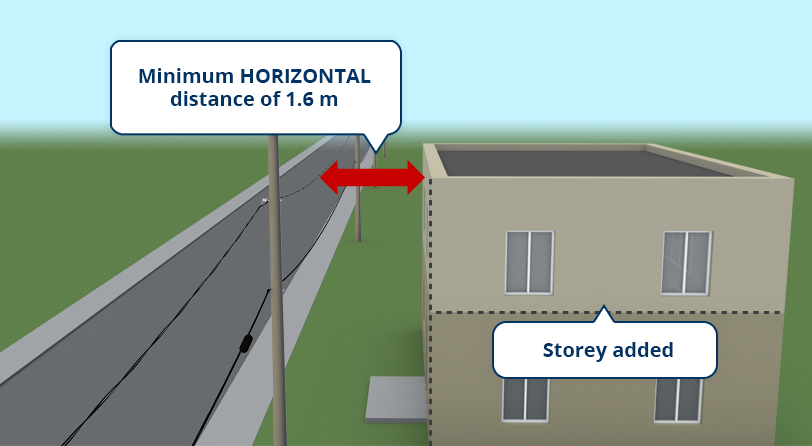What could happen if you fail to respect approach distances
- • The CNESST could halt your work if it is being performed within three metres of a power line and if the jobsite is not considered safe.
- • Hydro-Québec could have to move the power line—at your expense.
- • You could have to modify the building’s area or features . . . and reimburse your buyer.
- • Even if no one notices that the building is non-compliant, the danger is still very real. Someone could be seriously injured and you could be held responsible.
Avoid major and unnecessary troubles and costs right from the project design phase by respecting safe approach distances BEFORE starting work
Safety warning
When you need to estimate the distance to a line, EYEBALL it—don’t use a measuring instrument. If you estimate by eye that the distance is close to the minimum required, never try to measure it more accurately by placing anything at all near the line.
NEVER PLACE A TAPE MEASURE OR ANYTHING ELSE WITHIN 3 M OF A MEDIUM-VOLTAGE LINE.
Approach distance from medium-voltage lines
There must be a minimum HORIZONTAL distance of 3 m between any part of a building and the closest medium-voltage line.
Example: Adding a storey to a building near a distribution line


The HORIZONTAL distance may be less than 3 m under certain conditions
Example: Adding a building at a horizontal distance of less than 3 m from low-voltage lines may be allowed if BOTH these conditions are met:
- 1There’s a minimum VERTICAL distance of 4 m between the between the highest part of the building and the closest medium-voltage line.
- 2No part of a medium-voltage line passes over the building.
Example: Adding a garage at a horizontal distance of less than 3 m from medium-voltage lines may be allowed if BOTH these conditions are met:
- 1The medium-voltage lines don’t pass over the garage.
- 2The VERTICAL distance is at least 4 m.

Safety warning
No matter what the situation, if you estimate by eye that the distance is close to the minimum required, never try to measure it more accurately by placing anything at all near the line.
If you have any doubts, we’re here to help
Approach distance from LOW-voltage lines
There must be a minimum HORIZONTAL distance of 1.6 m between any part of a building and the closest low-voltage line. This applies to all configurations of low-voltage lines.
Example: Adding a storey to a building near a low-voltage line.


The HORIZONTAL distance between the building and the low-voltage line may be less than 1.6 m under certain conditions
Example: Adding a building at a horizontal distance of less than 1.6 m from twisted low-voltage lines may be allowed if BOTH these conditions are met:
- 1The low-voltage lines don’t pass over the building.
- 2There’s a minimum VERTICAL distance of 3 m between the highest part of the building and the low-voltage lines.
Example: Adding a building at a horizontal distance of less than 1.6 m from low-voltage lines may be allowed if ALL FOUR of these conditions are met:
- 1The low-voltage lines are twisted
- 2The lines don’t pass over the building.
- 3The part of the building closest to the line is hard to reach. (For example, it’s a pitched roof that you need a ladder to get to.)
- 4There’s a minimum VERTICAL distance of 1.5 m between the highest part of the building and the twisted low-voltage lines.

Safety warning
No matter what the situation, if you estimate by eye that the distance is close to the minimum required, never try to measure it more accurately by placing anything at all near the line.
If you have any doubts, we’re here to help

Approach distances from service entrance wires
The approach distances for service entrances are the same as for low-voltage lines. However, service loop lines may pass over a building—but only if they directly supply that building with power.
Pour en savoir plus sur les branchements et les distances sécuritaires :
Hazards and inconveniences of failure to respect approach distances
This is what could happen if your installation fails to respect the approach distances for power lines:
- You might have to change the building’s footprint or other features.
- Hydro-Québec might have to move the power line—at your expense. What’s more, your neighbors could be affected by the move, and not necessarily for the better—and that could mean trouble.
In keeping a safe distance from power lines, you’ll avoid a lot of problems, including wasting time and money.
Maybe no one will notice if you don’t follow the power line safety rules. But that doesn’t mean it’s not dangerous. Someone could be seriously hurt by touching a line that’s too close and then try to hold you responsible. If you’re the owner, you should also look ahead to when you sell your house. Irregularities will come back to haunt you.
You may also be interested in these pages
- What to check before doing any outdoor work
- Where can I put up a shed?
- How to avoid damaging power lines connecting my home to the grid
- What are Hydro-Québec servitudes and rights near distribution lines?
- Dangerous activities near power lines
- How Hydro-Québec can secure a jobsite near a distribution line